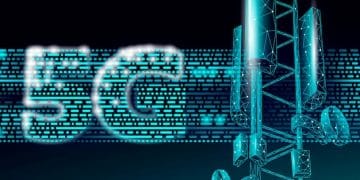US Quantum Edge: Government Investment’s Impact

The US government’s significant investment in quantum computing aims to secure a technological advantage by accelerating research and development, fostering public-private partnerships, and ensuring national security, positioning the nation at the forefront of this transformative field.
In a world increasingly shaped by technological prowess, the pursuit of innovation is a constant race. This leads many to ponder, will the US government’s investment in quantum computing give it a technological edge? This question delves into the complex interplay of advanced science, strategic funding, and national ambition, exploring whether this calculated gamble will solidify America’s position as a global leader.
The Dawn of the Quantum Era: A Strategic Imperative
The advent of quantum computing represents a paradigm shift, promising computational power far beyond anything classical computers can achieve. This isn’t just an incremental improvement; it’s a fundamental reimagining of how information is processed. For the United States, recognizing this transformative potential, investing in quantum computing isn’t merely an academic pursuit—it’s a critical strategic imperative.
Imagine solving problems that are currently intractable, from discovering new drugs and materials to optimizing complex logistical networks and breaking advanced encryption methods. This is the promise of quantum computing. The US government’s early and sustained investment reflects an understanding that leadership in this field will translate directly into economic dominance, national security advantages, and scientific breakthroughs that benefit humanity.
Understanding Quantum Computing’s Core
At its heart, quantum computing harnesses the principles of quantum mechanics, specifically superposition and entanglement. These phenomena allow quantum bits (qubits) to exist in multiple states simultaneously and to be intrinsically linked, creating an exponential increase in processing capabilities relative to classical bits.
- Superposition: Unlike a classical bit that is either 0 or 1, a qubit can be both 0 and 1 at the same time. This allows for massive parallel computation.
- Entanglement: Qubits can be linked such that the state of one instantly influences the state of another, regardless of distance. This forms the basis for highly complex quantum algorithms.
- Quantum Annealing: A specific type of quantum computing optimized for solving optimization problems, finding the best solution among many possibilities.
The technological edge sought by the US isn’t just about building faster machines, but about mastering the underlying science to unlock unprecedented computational power. This mastery will enable the development of new algorithms that can tackle today’s most challenging problems across various sectors, from finance to pharmaceuticals.
The very fabric of national security is intertwined with computational superiority. Nations that master quantum technologies first will likely hold significant advantages in cryptography, intelligence gathering, and defense systems. This understanding fuels the urgency and scale of US government investment, viewing quantum prowess as essential for maintaining geopolitical stability and safeguarding critical infrastructure.
Governmental Initiatives and Funding Allocation
The commitment of the US government to quantum computing is evident in a series of ambitious initiatives and substantial funding allocations. These efforts aim to not only accelerate research but also to build a robust ecosystem that supports innovation, talent development, and the eventual commercialization of quantum technologies.
A flagship program is the National Quantum Initiative Act, signed into law in 2018. This bipartisan effort authorized significant funding over several years to advance quantum information science. It established national quantum research centers, fostered collaborations between universities, national labs, and private industry, and aimed to secure America’s leadership in this burgeoning field.
Key Government Agencies and Their Roles
Several federal agencies play pivotal roles in the quantum computing ecosystem, each focusing on different aspects of research, development, and application.
- Department of Energy (DOE): Manages major national laboratories that are at the forefront of quantum research, including the development of quantum hardware and algorithms.
- National Science Foundation (NSF): Funds fundamental scientific research in quantum information science across academic institutions, fostering the next generation of quantum scientists and engineers.
- National Institute of Standards and Technology (NIST): Develops measurement standards and foundational technologies to ensure the reliability and interoperability of quantum systems.
- Department of Defense (DOD) / Intelligence Community: Focuses on the national security implications of quantum computing, including secure communications, advanced sensing, and code-breaking capabilities.
These agencies work in concert, creating a multifaceted approach that addresses both the foundational science and the practical applications of quantum technologies. The strategic allocation of funds across these diverse entities ensures a comprehensive push towards quantum supremacy, leaving no critical area underdeveloped.
Beyond direct funding, the government also employs indirect mechanisms to stimulate growth, such as tax incentives for R&D, loan programs for startups, and the creation of intellectual property frameworks that protect quantum innovations. These mechanisms are crucial for de-risking private sector investment and encouraging the rapid translation of lab discoveries into market-ready solutions. The overall intent is to weave a dense network of public and private collaboration, accelerating progress on multiple fronts and ensuring a long-term, sustainable competitive advantage for the nation in the global quantum race. The scale and coordination of these efforts underscore the strategic foresight behind the US government’s quantum gambit.
Public-Private Partnerships: A Synergistic Approach
A significant pillar of the US government’s strategy for achieving a technological edge in quantum computing lies in fostering robust public-private partnerships. This collaborative model recognizes that no single entity—neither government nor private industry—possesses all the necessary resources, expertise, or incentives to fully realize the potential of quantum technology on its own.
These partnerships aim to combine the foundational research capabilities of national laboratories and universities with the agility, market understanding, and scaling potential of private companies. The government provides significant funding, access to cutting-edge facilities, and a long-term vision, while private industry brings commercialization expertise, specialized engineering, and a competitive drive to develop practical applications.
Examples of Effective Collaborations
The landscape of quantum computing is replete with examples of successful public-private ventures, demonstrating the efficacy of this synergistic approach.
- Joint Research Initiatives: Universities and corporations often collaborate on specific research projects, co-funding efforts to overcome technical hurdles or explore new quantum algorithms.
- Consortia and Hubs: The National Quantum Initiative Act established multiple quantum research centers where academic, government, and industry scientists work side-by-side, sharing knowledge and infrastructure.
- Talent Exchange Programs: Programs that facilitate the movement of researchers and engineers between government labs, academia, and private companies help cross-pollinate ideas and accelerate skill development.
These collaborations are vital for translating theoretical breakthroughs into tangible technologies. They allow for the rapid prototyping of quantum devices, the testing of new algorithms on diverse quantum hardware, and the identification of challenges that require interdisciplinary solutions. Without this dynamic interaction, the pace of innovation would undoubtedly slow.
Furthermore, these partnerships help in addressing the critical talent gap in quantum computing. By pooling resources, they can create more attractive environments for top researchers and engineers, offering diverse career paths and access to state-of-the-art equipment. The synergy created by these relationships is not just about combining resources; it’s about fostering an ecosystem where innovation can flourish at an accelerated pace, ensuring that the US maintains a leading position in the complex global race for quantum supremacy. This proactive engagement between sectors is paramount for moving quantum from theoretical possibility to practical application, directly contributing to the nation’s technological standing.

The Race for Quantum Supremacy: Geopolitical Implications
The pursuit of quantum computing superiority is not just a scientific endeavor; it is a full-blown geopolitical race with profound implications for global power dynamics. The nation that achieves quantum supremacy first will likely wield unprecedented influence across economic, military, and diplomatic spheres.
Economically, quantum computing promises to revolutionize industries, leading to new markets, unparalleled efficiency gains, and potentially disruptive shifts in established sectors. A country that dominates quantum technology could set global standards, control key intellectual property, and attract the lion’s share of high-value quantum-related industries. This economic leverage would translate into significant geopolitical power.
National Security and Strategic Advantage
Nowhere are the stakes higher than in national security. Quantum computing has the potential to fundamentally alter the balance of power in several critical areas:
- Cryptography: Quantum computers capable of breaking current encryption standards (known as “quantum brute force”) could compromise secure communications worldwide. Conversely, quantum-resistant cryptography will be essential for protecting sensitive data.
- Intelligence Gathering: Enhanced computational power could allow for the analysis of vast datasets at speeds unimaginable today, yielding superior intelligence insights.
- Military Applications: From optimizing logistics and supply chains for military operations to developing more sophisticated defense systems and advanced materials for weaponry, quantum computing offers transformative capabilities.
- Cybersecurity: The ability to quickly identify and neutralize cyber threats, or conversely, to launch highly complex and undetectable attacks, will be a major differentiator.
The fear of a “quantum Pearl Harbor” – where an adversary suddenly develops quantum capabilities that render existing defenses obsolete – underscores the urgency of the US investment. This perceived threat drives significant government funding and strategic coordination, aiming to ensure that the US is not only prepared for a quantum-enabled future but is also a leader in shaping it.
Maintaining a technological edge in quantum computing is therefore not merely about prestige; it’s about preserving national sovereignty, protecting critical infrastructure, and ensuring the safety and prosperity of its citizens. The geopolitical landscape of the mid-21st century will undoubtedly be shaped by who wins this complex, high-stakes race, making the US government’s proactive investment a calculated necessity rather than a mere option.
Challenges and Hurdles on the Path to Edge
Despite significant investments and strategic initiatives, the path to achieving a definitive technological edge in quantum computing is fraught with considerable challenges and hurdles. The very nature of quantum mechanics, coupled with practical engineering difficulties and the nascent stage of the technology, presents formidable obstacles.
One of the primary challenges is the inherent fragility of qubits. They are extremely sensitive to their environment, easily losing their quantum properties (decoherence) due to minute disturbances like temperature fluctuations or electromagnetic interference. Maintaining coherence for long enough to perform complex calculations is a major engineering feat, often requiring cryogenic temperatures and extensive shielding.
Technical and Scientific Roadblocks
Beyond coherence, several technical and scientific roadblocks remain:
- Scalability: Building quantum computers with a sufficient number of stable, interconnected qubits is immensely difficult. Current systems are small and prone to errors.
- Error Correction: Quantum errors are prevalent and complex. Developing robust quantum error correction codes that can effectively mitigate these errors without overwhelming the system is a critical, unsolved problem.
- Algorithmic Development: While some theoretical quantum algorithms exist, translating complex real-world problems into quantum algorithms that can run efficiently on noisy, intermediate-scale quantum (NISQ) devices is challenging.
- Hardware Diversity: No single quantum computing hardware modality (e.g., superconducting qubits, trapped ions, topological qubits) has emerged as definitively superior, necessitating diverse research efforts which can disperse resources.
These technical barriers mean that a practical, large-scale, fault-tolerant quantum computer is still years, if not decades, away. The “quantum edge” is therefore not a fixed point but a moving target, dependent on overcoming these fundamental scientific and engineering challenges.
Furthermore, workforce development is a significant hurdle. There is a global shortage of experts with the interdisciplinary skills required for quantum computing, combining physics, computer science, engineering, and mathematics. Educating and retaining this talent is crucial for sustained progress. The investment in quantum computing, while substantial, must also be patient and persistent, navigating these complex scientific and engineering landscapes to eventually yield the promised technological advantage. It’s a marathon, not a sprint, with many unknowns along the route.

Future Outlook and Sustaining the Edge
Looking ahead, the future of quantum computing is undeniably bright, albeit challenging. The sustained investment by the US government, coupled with robust public-private partnerships, positions the nation favorably to build and maintain a technological edge. However, sustaining this edge will require continuous innovation, adaptability, and strategic foresight.
One key aspect of the future outlook involves transitioning from experimental, noisy intermediate-scale quantum (NISQ) devices to fault-tolerant, large-scale quantum computers. This leap will unlock the full potential of quantum algorithms for impactful real-world applications. Research efforts are heavily focused on improving qubit coherence, developing more efficient error correction techniques, and scaling up quantum chip fabrication.
Maintaining a Competitive Advantage
To sustain its technological edge, the US must focus on several critical areas:
- Education and Workforce Development: Investing in STEM education from an early age, creating specialized university programs, and training a skilled quantum workforce are paramount.
- International Collaboration and Diplomacy: While competing, strategic alliances with key international partners can accelerate progress and establish shared standards, fostering a responsible global quantum ecosystem.
- Ethical and Societal Considerations: Proactively addressing the ethical implications of quantum technologies, such as their potential impact on privacy and cybersecurity, will ensure responsible development and public trust.
- Agile Regulatory Frameworks: Developing flexible regulations that support innovation while mitigating risks will be crucial for maintaining a dynamic quantum industry.
The “edge” in quantum computing is not a static state but a dynamic position that must be continually earned. This requires not only scientific breakthroughs but also a national strategy that is agile enough to adapt to rapid technological changes and competitive pressures from other nations. The emphasis must shift from simply building quantum computers to building a comprehensive quantum ecosystem—one that includes hardware, software, algorithms, talent, and ethical guidelines. Only through such a holistic approach can the US truly secure and sustain a lasting technological advantage in this transformative field, ensuring that it remains at the forefront of the quantum revolution for decades to come.
Quantum Computing’s Impact on Daily Life
While the discussions around quantum computing often revolve around high-level scientific and geopolitical implications, it’s crucial to consider how this technology, once mature, could profoundly impact daily life for ordinary citizens. The “edge” the US seeks isn’t just for national security or economic might; it’s also about a future where problems previously considered unsolvable become tractable, leading to direct benefits for society.
Imagine personalized medicine becoming a reality. Quantum computers could simulate molecular interactions with unprecedented accuracy, accelerating drug discovery and optimizing treatments based on an individual’s unique genetic makeup. This could lead to cures for currently intractable diseases and more effective, side-effect-free therapies.
Transformative Applications in Key Sectors
The transformative applications of quantum computing are expected to permeate various sectors, directly improving aspects of daily life:
- Healthcare: Beyond drug discovery, quantum AI could enhance medical imaging, predict disease outbreaks, and revolutionize diagnostics, leading to earlier and more precise interventions.
- Materials Science: Designing new materials with specific properties, such as superconductors that could revolutionize energy transmission or catalysts for highly efficient chemical reactions, will impact everything from electronics to sustainable energy.
- Finance: Quantum algorithms could optimize financial models, detect fraud more effectively, and enhance the security of online transactions. This would lead to more stable markets and safer digital economies.
- Logistics and Transportation: Optimizing traffic flow in smart cities, streamlining complex supply chains, and improving global navigation systems could reduce congestion, waste, and travel times, making daily commutes and global trade more efficient.
Even though practical quantum computers for everyday use are still a distant reality, the foundational work being funded by the US government today lays the groundwork for these future breakthroughs. The “edge” gained in quantum computing research and development means that the US could be the first to realize these benefits, shaping the technological landscape and improving the quality of life for its citizens and potentially global society. This broad impact on daily life is a powerful, though often overlooked, motivation behind the extensive governmental investment in this cutting-edge technology.
| Key Point | Brief Description |
|---|---|
| 💡 Strategic Imperative | Quantum computing offers unparalleled power, vital for economic dominance, national security, and scientific breakthroughs. |
| 🤝 Public-Private Synergy | Collaborations between government, academia, and industry accelerate research and commercialization. |
| 🌐 Geopolitical Race | Leadership in quantum technology is crucial for global influence, especially in cybersecurity and defense. |
| 🚧 Overcoming Hurdles | Technical challenges like qubit fragility, scalability, and error correction require sustained effort and innovation. |
Frequently Asked Questions About US Quantum Investment
▼
The US government invests heavily in quantum computing to secure a long-term technological edge. This is crucial for national security, economic competitiveness, and solving complex scientific problems that are currently intractable with classical computers. It’s seen as a foundational technology for future global leadership.
▼
The National Quantum Initiative Act, enacted in 2018, is a bipartisan law designed to accelerate quantum information science. It provides significant funding for research, establishes national quantum centers, and fosters collaboration between government agencies, universities, and private industry to advance quantum technologies.
▼
Public-private partnerships are vital because they combine government funding and foundational research with private sector agility and commercialization expertise. This synergy accelerates research, translates discoveries into practical applications, and helps build a robust quantum ecosystem, including talent development.
▼
Key challenges include maintaining qubit coherence due to fragility, achieving scalability (increasing the number of stable qubits), developing effective quantum error correction, and creating practical quantum algorithms. These technical hurdles require significant ongoing research and engineering innovation for breakthroughs.
▼
Once mature, quantum computing could revolutionize various sectors, directly impacting daily life. This includes accelerating drug discovery for new medicines, developing advanced materials, enhancing cybersecurity for personal data, optimizing transportation and logistics, and improving financial modeling, leading to a more efficient and secure future.
Conclusion and the Quantum Horizon
The question of whether the US government’s substantial investment in quantum computing will deliver a decisive technological edge is not a matter of if, but how profoundly and how soon. The strategic foresight demonstrated through initiatives like the National Quantum Initiative Act and the emphasis on public-private partnerships underscores a national commitment to leading this transformative field. While formidable scientific and engineering challenges persist, the relentless pursuit of quantum supremacy is driven by its immense potential to reshape everything from national security and economic power to healthcare and daily life. The “edge” will be defined not just by technological breakthroughs but by the establishment of a resilient, innovative quantum ecosystem that continually pushes the boundaries of what’s possible, ensuring America remains at the forefront of the quantum era.





